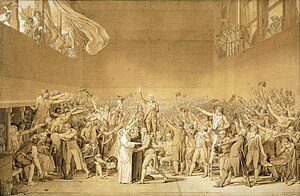ටෙනිස් පිටියේ දිවුරුම
The Tennis Court Oath (ප්රංශ: serment du jeu de paume) was a pivotal event during the first days of the French Revolution. The Oath was a pledge signed by 576 out of the 577 members from the Third Estate during a meeting of the Estates-General on 20 June 1789 in a tennis court.

On 17 June 1789 this group, led by Honoré Gabriel Riqueti, began to call themselves the National Assembly.[1] On the morning of 20 June the deputies were shocked to discover that the doors to their chamber were locked and guarded by soldiers. Immediately fearing the worst and anxious that a royal attack by King Louis XVI was imminent, the deputies congregated in a nearby indoor real tennis court where they took a solemn collective oath "not to separate, and to reassembly wherever circumstances require, until the constitution of the kingdom is established"[2]
The deputies pledged to continue to meet until a constitution had been written, despite the royal prohibition. The oath was both a revolutionary act, and an assertion that political authority derived from the people and their representatives rather than from the monarch himself. Their solidarity forced Louis XVI to order the clergy and the nobility to join with the Third Estate in the National Assembly.[3]
The only deputy recorded as not taking the oath was Joseph Martin-Dauch from Castelnaudary.[4] He can be seen on the right of David's sketch, seated with his arms crossed and his head bowed.
Significance
සංස්කරණයThe Oath signified the first time that French citizens formally stood in opposition to Louis XVI, and the National Assembly's refusal to back down forced the king to make concessions. The Oath also inspired a wide variety of revolutionary activity in the months afterwards, ranging from rioting across the French countryside to renewed calls for a written French constitution.
Moreover, the Oath communicated in unambiguous fashion the idea that the deputies of the National Assembly were declaring themselves the supreme state power. From this point forward, Louis XVI would find the Crown increasingly unable to rest upon monarchical traditions of divine right.
References
සංස්කරණය- ^ P105, Doyle, William The Oxford History of the French Revolution (1989)
- ^ "Tennis Court Oath". 2008. සම්ප්රවේශය 2008-01-24.
- ^ Doyle, William (1989). The Oxford History of the French Revolution. Oxford: Clarendon. p. 107. ISBN 0198227817.
- ^ see Historical Dictionary of the French Revolution by Paul R. Hanson
